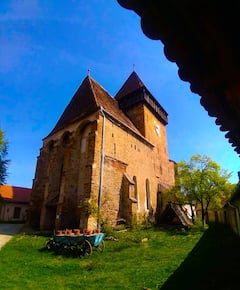One of the best ways to experience a new culture is through food. But when you get to a new country, you might not know very well where to start, maybe the menu is just in the local language, maybe the waiter doesn’t speak good enough English in order to make good recommendations, so you might end up not enjoying the food you order, although the country you’re in has a lot of good food to offer. Romania is one of those countries where it might happen that the menu is not translated (or the translations don’t say much) and where you might end up just ordering pizza or pasta, just because you don’t know what the local cuisine is. This article is intended to be a food guide to help you choose wisely when you get into a Romanian restaurant.
1. How and what do Romanians eat?

Romanians like to eat and they can eat a lot. They can go as far as having a four course meal on a daily basis: a starter, a soup, the main course and dessert. If you happen to visit a Romanian family during Christmas or Easter, a birthday party or a wedding, you will easily realize the importance of food in this country. At these special occasions, you can have up to six, seven or even eight course meals! And by the way, in Romania soups are not considered a starter, but they are also not the main course. That’s why in most menus, soups would just be under a different category, not mixed with starters, nor with main courses. Let’s start our tour of Romanian food.
2. What starters can you get?

As starters, you can either get cold meat - ham, bacon, smoked sausages (cârnați afumați), pork fat (slănină), pork scraps (jumări) or you can choose a vegetarian spread. My recommendations are salată de vinete and/or zacuscă. Salată de vinete is an eggplant salad (roasted eggplant mixed with fresh onion and oil or mayonnaise). It’s best served with fresh tomatoes. Zacuscă is a vegetable spread (roasted eggplant or mushrooms, peppers, tomatoes mixed and cooked together for a long time). Both of them are served cold as spreads. They are both great snacks while waiting for your main course to arrive. You can also find zacuscă in supermarkets, both the eggplant type (de vinete) and the mushroom type (cu ciuperci). They are packed in glass jars, usually located around the canned food. The homemade version is, of course, better, but the supermarket version is still good and very convenient in case you’re organizing a picnic.
3. Too many soup options

There are two different types of soups in Romania: ”supe” and ”ciorbe”. ”Supe” are usually clear soups made with chicken stock. The two most popular options are supă de tăieței and supă cu găluște. Supă de tăieței is a clear soup with thin usually homemade pasta, supă cu găluște is a clear soup with semolina dumplings. ”Ciorbe”, on the other hand, are usually quite heavy dishes and they often contain meat. They are often served with sour cream and green chili on the side. Ciorbă de văcuță is soup with vegetables and beef, ciorbă de perișoare is soup with meatballs, ciorbă de fasole is beans soup usually with smoked meat. If you’re a vegetarian, the options that I recommend are either ciorbă de legume (vegetable soup) or supă cremă de ciuperci (cream of mushroom soup).
You might be interested in these Airbnbs!
4. What's for the main course?

A lot of meat options again! Romanians really like their meat. The traditional tochitură consists of layers of polenta (maize meal), cheese, sausages (usually pork) and an egg on top. However, some restaurants will serve ”tochitură moldovenească” (Moldavian tochitură) which is beef stew with polenta on the side. Another favourite in Romania are sarmale. These are cabbage rolls (minced - pork or beef - mixed with rice packed in cabbage or wine leaves and boiled together with smoked meat - usually pork). They are usually served with polenta on the side. Iahnie de fasole (mashed beans with garlic) can be a side dish for grilled sausages. For meat lovers, you can also order mici or mititei. These are some sort of skinless grilled sausages, or meat balls shaped like sausages. Most Romanians would have them with French fries, mustard and a glass of beer.
5. Getting some sweetness at the end of the meal

Almost every country has its own version of doughnuts. In Romania, they are called papanși. These are some sort of doughnuts served with sour cream and blueberry, raspberry or sour cherries jam. They are served warm. Another typical Romanian dessert is gomboți, also called găluște cu prune. These are mashed potato balls filled with plums and baked until the plum inside gets soft. They are afterwards rolled in breadcrumbs mixed with brown sugar. Romanians also like French crepes a lot (clătite). Every restaurant will offer a wide range of fillings, usually jam, chocolate spread or custard.
6. A few things to consider when ordering your meal

Romanians usually order bread separately, the waiter will usually ask if you want bread or not. It might also happen, though, that they assume you want it, so you’ll see it on the bill at the end. It is often the case that Romanians would order a salad with their main dish (not if you’re ordering sarmale or tochitură, though), so it might be the case that the waiter will ask you if you want a salad. The salad can be raw cabbage salad, mixed tomatoes and cucumber, green lettuce salad or pickle salad (this goes well with iahnie de fasole).
As dressing, Romanians usually only use vinegar, olive oil, salt and pepper. It happens often that the portions are rather big and very filling, so it might be a better idea to order one dish at a time, rather than 3 course meals; you might not be able to finish. Romanians like to eat a lot of meat. In case you’re a vegetarian, your options will be limited, but you can always ask for “mâncare de post” (lent food); the only time when Romanians are vegetarians is during Christmas or Easter lent. You might also want to combine one or two side dishes, like polenta with cheese and grilled vegetables or cream of mushroom soup. Salată de vinete, zacuscă and iahnie de fasole are also good options. If you are strict with your vegetarian diet, make sure to ask specifically about it before ordering, as sometimes even if it might seem from the menu that the dish you want to order contains no meat, it’s not always the case.
7. A few good restaurants that you should try while in Romania
There are many traditional restaurants in Romania. These are just a few of the more famous ones.
Caru cu Bere, Bucharest
Address: 5, Stavropoleos Street, Bucharest
Price: from 15 USD
Access: 5 minutes walk from Unirii subway station
Contact: +40213137560
Read more: Caru cu Bere
Restaurant Rustic, Hunedoara
Address: Strada Libertatii 4, Hunedoara 331128, Romania
Price: from 10 USD
Access: 15 minutes walk from the city center
Contact: +40254713424
Website: Restaurant Rustic
Casa bunicii, Timișoara
Address: Strada Virgil Onițiu 3
Price: from 15 USD
Access: 10 minutes walk from Unirii Square
Contact: +40356100870
Website: Casa bunicii, Timișoara
Don't postpone your Romanian feast!
There is so much good food in Romania waiting for people to enjoy it. Don’t postpone this trip, you won’t regret it, even if by the end of your trip the scale might show a few extra kilos/pounds. Food is a big part of the culture, experiencing it is a must!
History
Get Trip101 in your inbox
Unsubscribe in one click. See our Privacy Policy for more information on how we use your data






















Create an account to